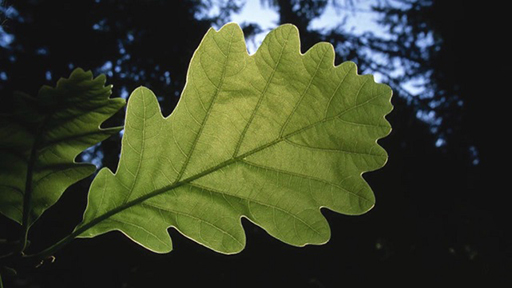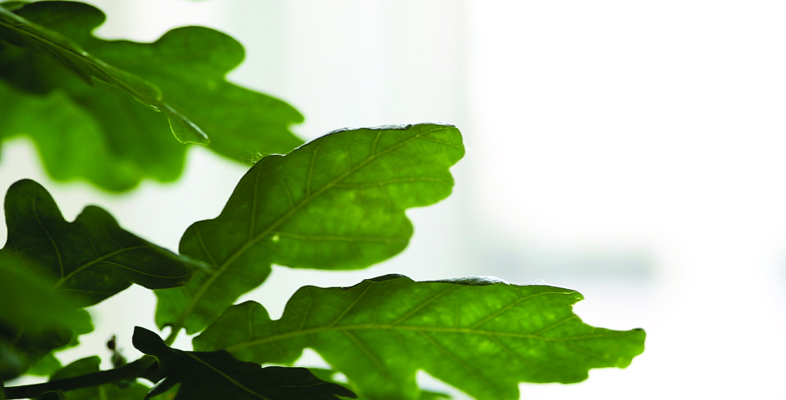2.7 An oak leaf
In the following video you will learn that leaves are organs to collect light and carbon dioxide. There is a substantial diversity of leaf sizes among plant species. You will also learn about the size and longevity of oak leaves. When you have watched the video, you will carry out some calculations to determine how much leaf size varies across plant species, how many leaves an oak might produce in its lifetime. You will also consider the benefits and limitations of making estimates.
While watching the video, record the following information to use in the questions that follow:
- the leaf length of the Amazonian water lily and tiny Wolffia leaves
- the size of an oak leaf (length)
- the approximate lifespan of a leaf (in months or weeks)
- the number of leaves on trees of different ages
- the thickness of an oak leaf, and the amount of time that leaves take to expand.

Transcript: The lifetime of oak leaf
To begin with, get a feel for the range of leaf sizes across species.
Question 1
The video describes one of the largest simple leaves as the Amazonian waterlily (genus Victoria) and one of the smallest from the genus Wolffia. How many orders of magnitude are there between the leaf lengths of these two organisms?
Question 2
Oak leaves can vary in size depending on the environmental conditions in which the tree is growing. These include whether the leaves grow in the sun or shade. To simplify the calculations, the video reports a leaf length measured from a local tree, rather than providing a range of lengths. What is that length?
Question 3
Question 4
Oak leaves are one type of plant organ, and the woody trunk is another. The leaves are discarded each year, but the trunk continues growing bigger and bigger. Given this information, what might you predict about how long the cells in each organ type might last? (You answer should be 1–2 sentences.)
Answer
Almost certainly, the cells in the woody trunk survive for much longer than those in the leaves. In an oak, nutrients from the leaves are stored in the oak wood over the winter so these cells last much longer than the leaves.
Question 5
Using the average number of leaves per tree in given age brackets that you recorded from the video, calculate how many leaves an 800 year old tree could have produced in its life. You may like to use a table, such as Table 6 below, to help you make the calculations (the first row here has already been completed).
Report the answer without rounding for significant figures.
| Age bracket/years | Number of years spent in this age bracket | Number of leaves produced each year | Total number of leaves produced during age bracket | ||
|---|---|---|---|---|---|
| 1–20 | 20 | × | 10 000 | = | 200 000 |
| 21–100 | × | = | |||
| 101–500 | × | = | |||
| 501+ | × | = | |||
| Total: | |||||
Answer
The completed Table 6 is shown below:
| Age bracket/years | Number of years spent in this age bracket | Number of leaves produced each year | Total number of leaves produced during age bracket | ||
|---|---|---|---|---|---|
| 1–20 | 20 | × | 10 000 | = | 200 000 |
| 21–100 | 80 | × | 200 000 | = | 16 000 000 |
| 101–500 | 400 | × | 400 000 | = | 160 000 000 |
| 501+ | 300 | × | 300 000 | = | 90 000 000 |
| Total: 266 200 000 | |||||
Using the data in the video, you can calculate that an 800 year old oak could have produced 266 200 000 leaves in its lifetime. That’s nearly 300 million leaves!
Discussion
Are you surprised at this number? Did you ever consider that a tree might produce this many leaves over its lifetime? Scientists estimate the number of leaves on a tree for multiple reasons, but some examples are to:
- estimate the amount of whole-tree photosynthesis or carbon fixation
- determine how much of a tree’s resources are allocated to leaves compared to other parts of the plant
- consider how much light is intercepted or if self-shading occurs, and
- estimate nitrogen use.
Question 6
In Question 5, you estimated the number of leaves an 800 year old oak could produce in its lifetime. Give a reason why it is useful to estimate a number like this instead of determining the number exactly.
Answer
One reason is that you can get a good estimate using techniques including digital imaging without damaging the tree. Cutting down a tree and counting the leaves is one way to determine leaf number, but clearly that’s not possible to do multiple times in its lifetime.
Another reason is it is clearly extremely difficult, if not impractical, to count all of the leaves on a tree every year for 800 years, and it is very unlikely that you could provide an accurate number. (It would take generations of people collecting every single fallen leaf and counting them!)
Question 7
Based on the information in Question 5 suggest two limitations, or sources of error, with approximating the number of leaves in this way.
Answer
There are several possible limitations; here are two.
- The age brackets (time spans) for each of the growth periods, particularly the latter two, are very large (100 years and 500 years, respectively) so any error in the average annual number of leaves will be magnified when multiplied by such large numbers and will render the estimate inaccurate.
- The leaf numbers for each age range are averages determined from other plants of the same species, but likely to be growing in a different area. The actual oak tree under scrutiny will almost certainly have produced a different numbers of leaves.
Question 8
Using the details you recorded regarding how thick oak leaves are, and how long it takes them to grow, add the bar ‘Oak leaf expansion’ to the size–time explorer [Tip: hold Ctrl and click a link to open it in a new tab. (Hide tip)] .
Summary
Here you determined the order of magnitude that leaf sizes can vary across plant species and considered the dimensions of an oak leaf. In addition, you used a table to help organise numbers in a multi-part calculation when you estimated the number of leaves an ancient oak produces in its lifetime. By making calculations such as these, you can better appreciate the implications of the deciduous nature of oak leaves.
Next: Now look at the components of a leaf at even smaller scale by examining a stomata (the pores on a leaf), which you can do with the ‘Next >’ button, or you can return to the size–time explorer and pick a new level yourself.
